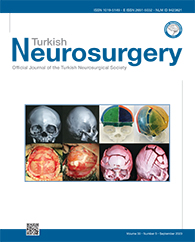2University of Health Sciences, Kartal Dr. Lütfi Kırdar City Hospital, Department of Plastic, Reconstructive and Aesthetic Surgery, Istanbul, Turkey
3Liv Hospitals, Vadi İstanbul, Department of Neurosurgery, Istanbul, Turkey
4Gazi University, Faculty of Science, Department of Biology, Ankara, Turkey
5Marmara University, Pendik Training and Research Hospital, Department of Pathology, Istanbul, Turkey DOI : 10.5137/1019-5149.JTN.41370-22.2 AIM: To understand the characterization of the ossification process both in the synostotic suture, and the adjacent parietal bone.
MATERIAL and METHODS: The surgical procedure for the 28 patients diagnosed with sagittal synostosis consisted of removing the synostotic bone as a whole, if possible, ?Barrel?Stave? relaxation osteotomies, and strip osteotomies to the parietal and temporal bones perpendicular to the synostotic suture. The synostotic (group I) and parietal (group II) bone segments are obtained during osteotomies. Atomic absorption spectrometry was used to determine the amount of calcium in both groups, which is an indicator of ossification. Scanning electron microscopy and immunohistochemistry were employed to assess trabecular bone formation, osteoblastic density, and osteopontin, which is one of the in vivo indicators of new bone formation.
RESULTS: Histopathologically, trabecular bone formation scores did not indicate any significant difference between the groups. However, the osteoblastic density and calcium accumulation in group I were higher than those in group II, and the difference was significant. Osteopontin staining scores in cells showing membranous and cytoplasmic staining with osteopontin antibodies significantly increased in group II.
CONCLUSION: In this study, we found reduced differentiation of osteoblasts despite their increase in number. Moreover, the osteoblastic maturation rate was low in synostotic sutures, bone resorption becomes slower than new bone formation, and the remodeling rate is low in sagittal synostosis.
Keywords : Craniosynostosis, Electron microscopy, Osteoblast, Osteopontin, Sagittal synostosis




